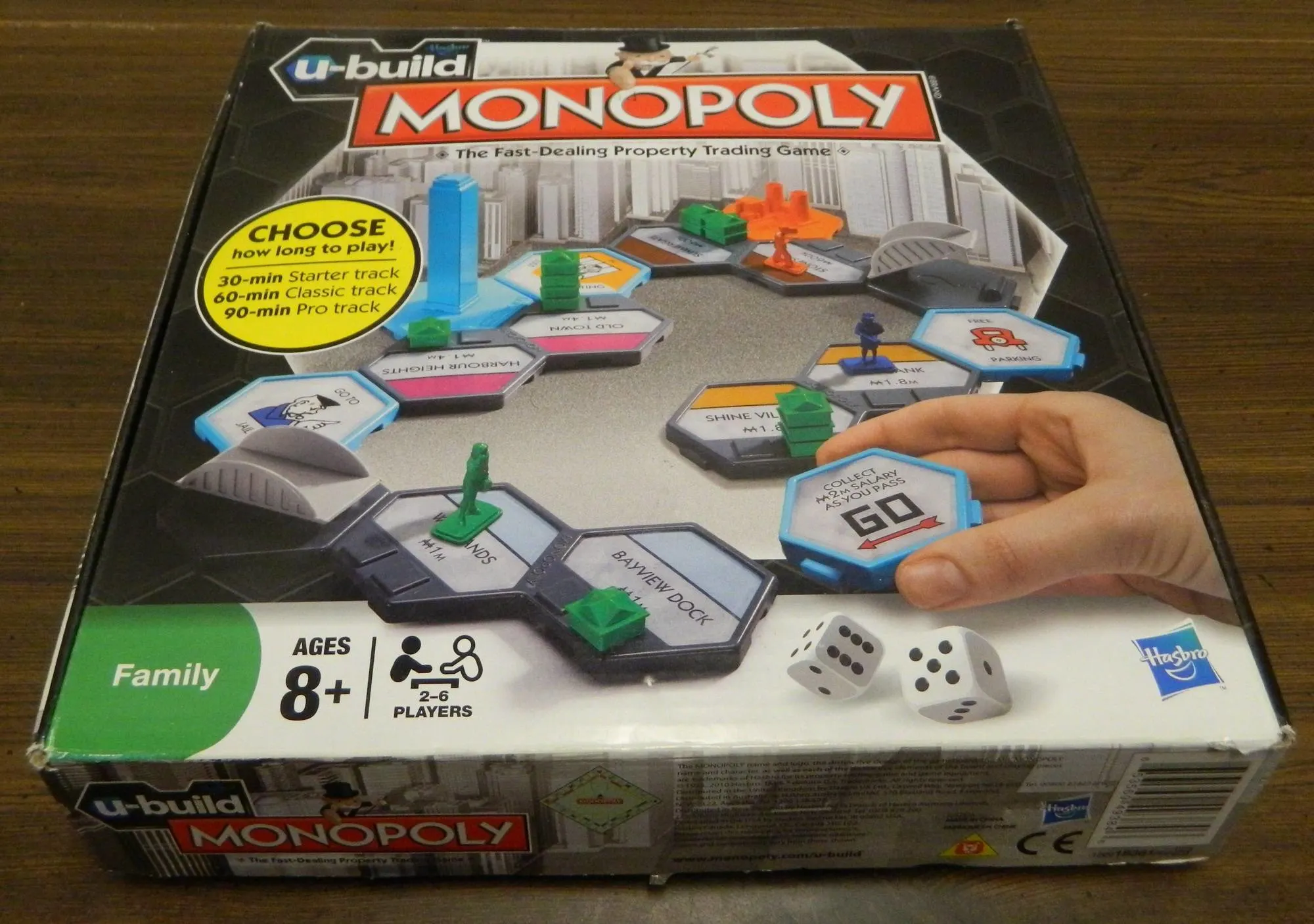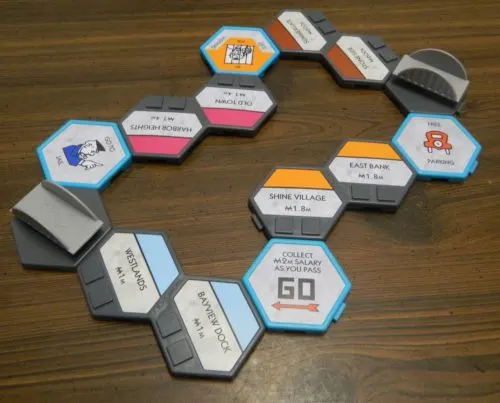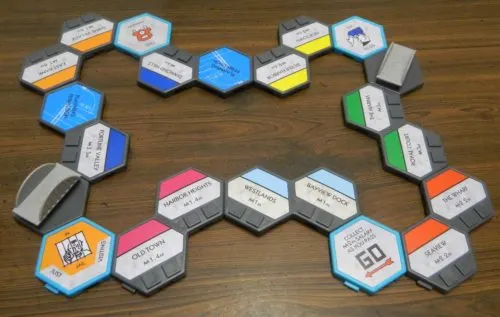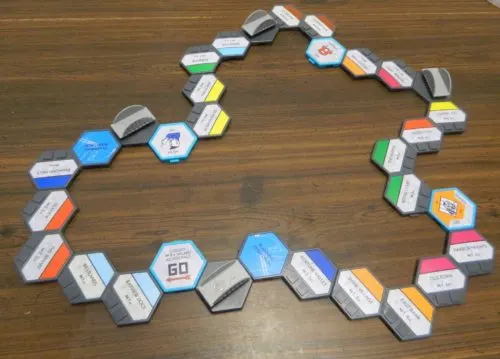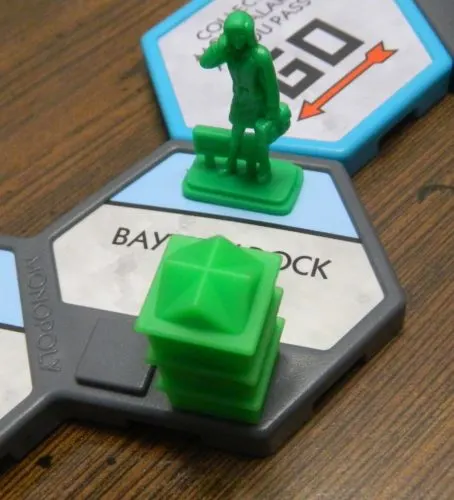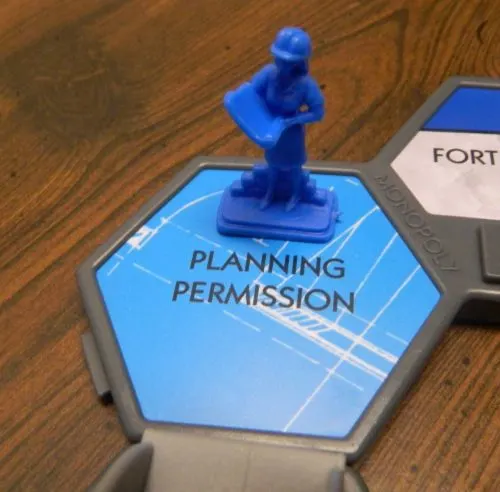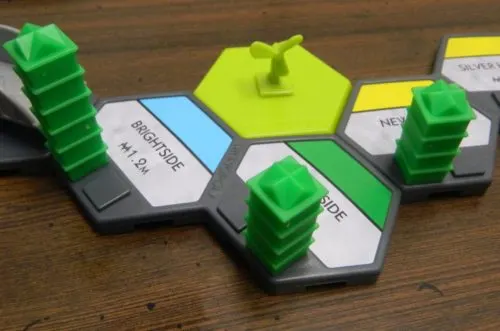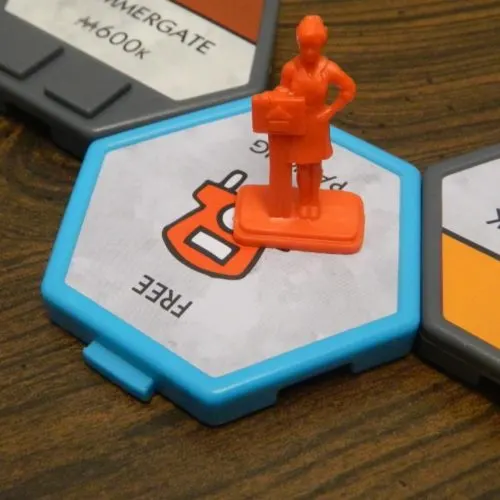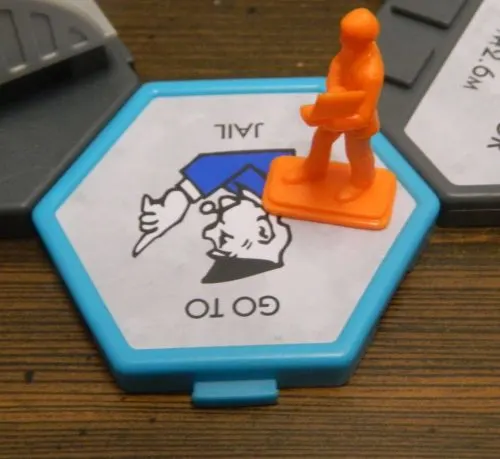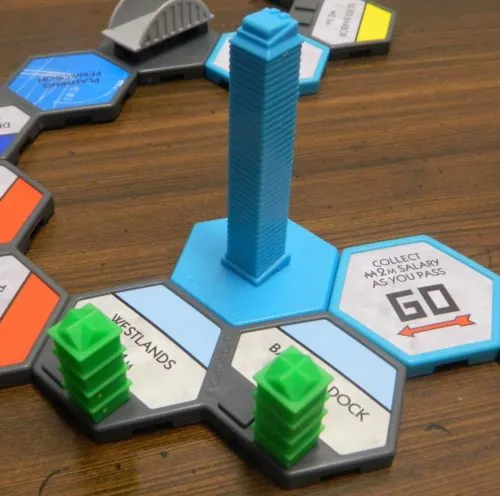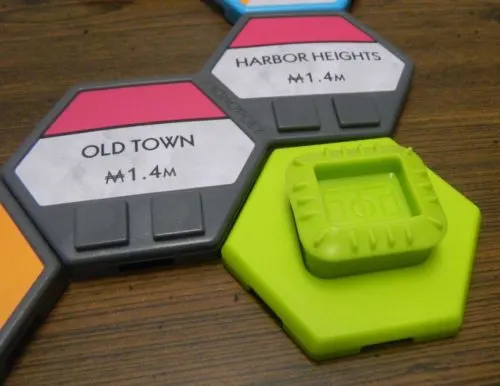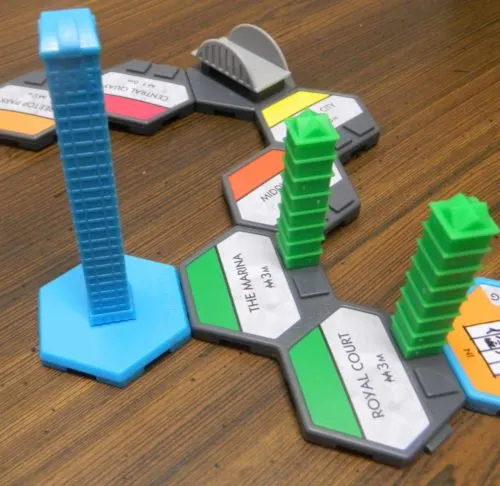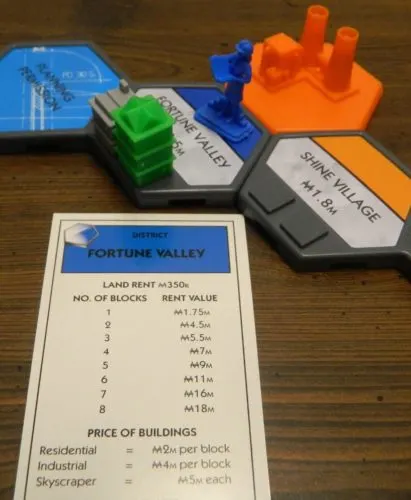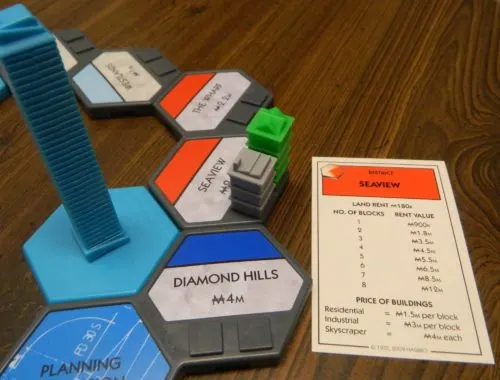Monopoly is probably one of the most debated board games of all time. It is arguably the most popular board game of all time and a lot of people love it. There are probably just as many board game aficionados that absolutely despise the game though. I personally would place myself somewhere in the middle as there are things about Monopoly that I enjoy but there are obvious problems with the Monopoly formula as well. Over the years there have been many attempts to try and fix the problems with Monopoly to varying degrees of success. When Hasbro decided to create their U-Build line of games, it should come as no surprise that Monopoly was one of the games chosen. Based on the other games in U-Build line that I had played, I had little faith in U-Build Monopoly. After reading the instructions I was intrigued because the game actually had some interesting ideas to add to the Monopoly formula. U-Build Monopoly actually showed a lot of potential to improve upon the original Monopoly but ultimately failed leading to an experience arguably worse than the original Monopoly.
How to Play U-Build Monopoly
Setup
Setup depends on whether you choose to use the starter, classic, pro, or your own custom board. These setup steps are followed no matter what board you choose to use:
- Shuffle the chance cards and place them face down next to the table.
- Each player chooses a playing piece and places it on the start space.
- All of the players roll the dice (only one die if the starter board is chosen). The player who rolls the highest total gets to start the game.
Starter
- Setup up the board as shown above.
- Choose one hazard, one bonus building and two skyscrapers to use in the game. 40 residential blocks will also be used in the game.
- Give each player the following amount of money:
- 2-5M
- 2-1M
- 1-500k
- 1-200k
- 1-100k
- 1-50k
- 5-10k
Classic
- Setup the board as shown above.
- The school, park, power station, prison, 2 skyscrapers, and the monopoly tower will be used in the game. 40 residential blocks and 20 industrial blocks will be used in the game.
- Give each player the following amount of money:
- 4-5M
- 4-1M
- 1-500k
- 1-200k
- 1-100k
- 1-50k
- 5-10k
Pro
- Setup the board as shown above.
- All of the building are used in the game.
- Give each player the following amount of money:
- 5-5M
- 5-1M
- 2-500k
- 2-200k
- 2-100k
- 1-50k
- 5-10k
Playing the Game
A player’s turn will follow these steps:
- Roll and move clockwise.
- Take an action based on the space your playing piece landed on.
- Build up to three residential/industrial blocks on a district you own (optional).
- Move a hazard one or two spaces (optional).
- If you rolled doubles you get to roll again. Otherwise play passes to the next player clockwise.
Moving Your Playing Piece
A player begins their turn by rolling the dice (only roll one die if playing using the starter board). The player moves their playing piece around the board clockwise the number of spaces rolled. While moving past a couple special spaces a player will have to take a special action.
- If a player passes a bridge that is currently up, they will pay 1M to the bank and then close the bridge.
- If a player passes Go they will receive 2M from the bank.
Take an Action
The player will then take an action based on the space that their piece landed on.
Unowned District: When you land on an unowned district you can choose one of two options. First you can choose to purchase the district. Pay the price of the district to the bank and take the corresponding property card. If you don’t want to purchase the district it will be put up for auction. The player who landed on the space starts the auction (the minimum bid is 10k). Players can keep raising the bid (without having to take turns) until no one wants to bid higher. The highest bidder pays the bank and takes the corresponding property card.
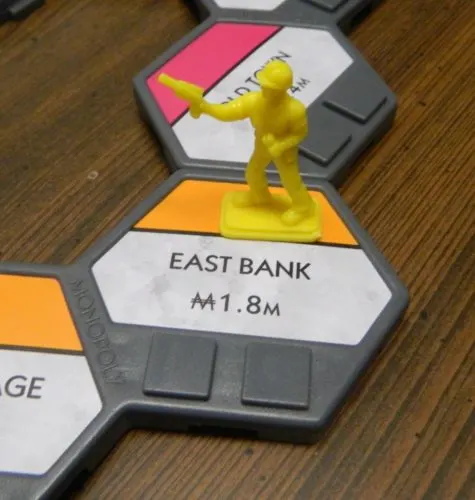
This district is currently not owned. The yellow player can pay 1.8M in order to purchase the district. If they choose not to purchase it, the district will go up for auction.
District Owned By Another Player: You will pay the player that owns the district the required amount of rent. Check out the Rent section below for more information.
Your Own District: You will take no special actions. You can still add residential/industrial blocks and/or move a hazard.
Planning Permission: When a player lands on a planning permission space they can take one of three actions:
- Build a bonus building next to one of the districts you own. This bonus building prevents a hazard from being placed next to a district touched by the bonus building. You cannot build a bonus building next to a district that is impacted by a hazard.
- Place one of the hazard buildings on the board (see Hazard section below).
- Move one of the hazards already on the board (see Hazard section below).
Free Parking: You will take no special actions. You can still add residential/industrial blocks and/or move a hazard.
Bridge: If the bridge is up, pay 1M to the bank and close the bridge. If the bridge is down, open it. In either case take the top chance card. The side of the chance card that applies to you depends on whether the bridge you landed on is up or down. If possible you must follow the instructions on the card before continuing your turn.
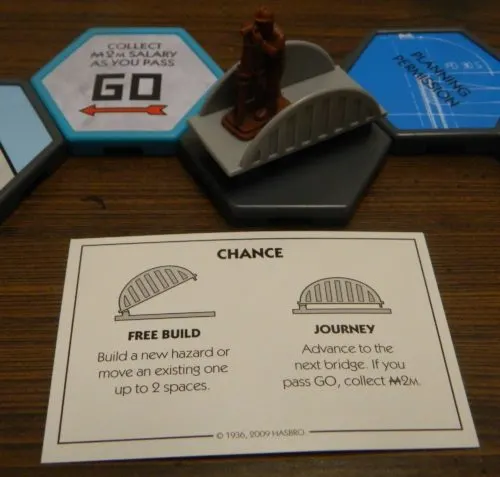
This player has landed on a bridge space. The bridge was open so they had to pay 1M to close the bridge. Since the bridge is closed the player will advance to the next bridge due to the chance card that was drawn.
Go to Jail: Immediately move your playing piece to the jail space.
Adding Residential and Industrial Blocks
After taking the action based on the space that they landed on, a player has the option of adding residential and/or industrial blocks to one of the districts that they own. Unlike normal Monopoly you do not need to own all of the properties of a color before you begin adding to a property. As soon as you purchase a district you can begin adding residential and industrial blocks. During your turn you can add up to three buildings to one of the districts that you own. Each district can have a maximum of eight buildings total. The cost of purchasing a building is listed on the bottom of the property cards.
Players can choose between adding residential buildings and/or industrial buildings to a district. In the starter game you can only build residential buildings. Residential building are cheaper to add to a property but they become worthless if a hazard is placed next to the district. Industrial buildings are more expensive to build but they are not impacted by hazards.
Instead of adding residential or industrial blocks a player can choose to build a special building if they meet the requirements.
Skyscraper: A skyscraper can be purchased when you own all of the districts of one color. The cost to build the skyscraper depends on the property card. You place the skyscraper next to any district of the color you control. The skyscraper doubles the rent of all of the districts of the color you purchased the skyscraper for.
Stadium: A stadium can be purchased when you own two districts of the same color. You place the stadium next to one of the two districts of the same color that you control. The stadium allows a player to collect 3M each time they pass go instead of the normal 2M. The stadium does not block a hazard from being placed next to a district.
The Monopoly Tower: The Monopoly Tower can only be purchased if you own all of the districts of two different colors. The Monopoly Tower can be placed next to a district of either color. The Monopoly Tower doubles the rent of all of the districts that the player who builds it owns. To purchase the Monopoly Tower you have to pay 7M to the bank.
Hazards
When a hazard is placed on the board or moved, it will affect every district that it touches. The hazard cannot be placed or moved next to a district that is protected by a bonus building. When a hazard is impacting a district, all residential blocks do not add any value to the rent.
If a player lands on the planning permission space they can choose to move move a hazard up to two spaces for free. Otherwise players can move a hazard up to two spaces on their turn. For each space that a hazard is moved, the player has to pay 1M.
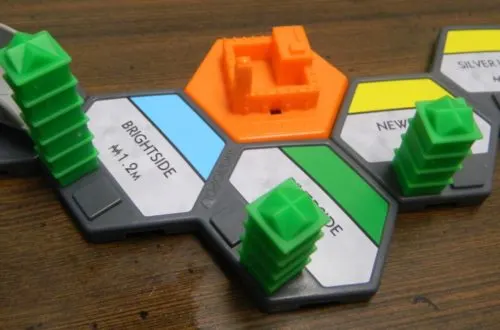
This hazard impacts these three districts so none of these residential buildings will raise the rent for their districts. Players can pay 1M to move the hazard one space. One space would move the hazard next to the two yellow districts, between the green and yellow district, to the other side of the green district, between the light blue and green district, to the other side of the light blue district, or one space to the left between the light blue district and the neighboring district.
Rent
The amount of rent that you can charge a player depends on a couple different factors.
- If the district has no buildings on it, you can only charge the “land rent” shown on the property card.
- If the district has buildings on it, the number of buildings you can use for rent depends on whether the district is impacted by a hazard. If it is impacted by a hazard you only count the industrial buildings. If it is not impacted by a hazard you count both the residential and industrial buildings. To determine rent look at the number corresponding to the number of buildings you have on the property.
- If the district has a skyscraper, you charge double the rent. If you control the Monopoly Tower you can also charge double rent. If both apply to a district you can only double the rent once.
If a player cannot afford the entire rent they must either mortgage properties or do a deal with one of the other players to sell off districts. You cannot sell back buildings to raise money. When a player trades a property all buildings transfer to the player who purchases it.
Mortgages
If a player would like to mortgage a district, the property is worth the current rent value ignoring any doubling from a skyscraper/Monopoly Tower. When a player mortgages a district they turn the corresponding property card over and receive the corresponding amount of money from the bank. While a property is mortgaged a player receives no rent if a player lands on it.
When a player wants to pay off a mortgage, they pay the current rent value to the bank. They can then turn the district card back over and start charging rent again.
Jail
A player can be sent to jail in the following ways:
- Drawing a chance card that sends you to jail.
- Landing on the “Go to Jail” space.
- Rolling doubles three times on the same turn.
When a player is sent to jail their turn ends immediately. When in jail a player can only bid in auctions and collect rent. When in jail you can either pay a 500k fine (to the bank) or roll the dice. If you roll doubles you move out of jail with the number you rolled. In the starter game you need to roll a six to get out of jail.
If a player rolls the dice three times in jail and doesn’t roll doubles/a six, they must pay the 500k fine and leave jail.
End of Game
The game ends when one of the players is forced to declare bankruptcy. If the player who goes bankrupt owes money to the bank, they give all of their money and district cards to the bank. If the player owes another player, they give them all of their money and district cards that they haven’t mortgaged.
All of the players then calculate their net worth as follows:
- Count up your cash on hand.
- Add up the current rent values of all of the districts that aren’t mortgaged.
Players compare their net worth. The player with the highest net worth wins.
My Thoughts on U-Build Monopoly
Of all of the problems that people have with Monopoly, the general consensus is that the original Monopoly is way too long. Of all of the things that U-Build Monopoly addressed, this seems to be the one thing that the designers were most focused on heading into U-Build Monopoly. The problem with the original Monopoly is that it can feel like the game is never going to end. If you follow the game’s actual rules playing until all but one player has gone bankrupt, the game can easily take 90 minutes up to several hours. Outside of the most diehard fans, I think everyone can agree that the original Monopoly takes way too long to play.
So how does U-Build Monopoly address the length issue? Well it actually does it in a couple different ways. First it shortens the length of the gameboard. In the starter and classic tracks there are quite a few less spaces than the original game. This allows players to move around the board quite a bit quicker. With less spaces it also means that it is much easier for the players to land on all of the properties. Since a player either buys a property or it goes up for auction, this means that all of the properties can be acquired quicker. When most/all of the properties have been purchased, it is likely that players will land on a property where they will have to pay another player. With players having to pay out more often, it makes it is easier for players to go bankrupt.
The other area that really speeds up U-Build Monopoly is the fact that you no longer have to collect monopolies in order to start building on your properties. As soon as you buy a property you can start building houses on it immediately. This speeds up the game in two ways. First players no longer have to wait around for Monopolies to get anything accomplished in the game. It might just be my group but players rarely ever agree to make trades. For a trade to happen both players have to get a monopoly of roughly the same value. This usually leads to players refusing to trade with one another because no one can ever come up with a trade that is fair to both players. Outside of the length this might be the biggest problem that I have with the original Monopoly.
The other reason why getting rid of the need to get a monopoly speeds up the game is that players can build houses immediately to create valuable properties. This increases the odds of a player going bankrupt. In the original game if no player has a monopoly, players nickel and dime one another until someone is forced to sell/trade one of their properties. This seems to take forever since money just goes back and forth between the players. With U-Build Monopoly though you can quickly build up a property to the point where its rent is so high that it will severely hinder another player. If a player ends up hitting several of these high rent properties they can actually go bankrupt pretty quickly.
The final way that Monopoly shortens the game is by adjusting the end game. In the original game you have to play until all but one of the players have gone bankrupt. In U-Build Monopoly the game ends when the first player has gone bankrupt. The rest of the players then just total up their wealth and the player with the most money wins the game. As one player is usually pretty far in the lead at the time of the first bankruptcy, this is usually going to just cut out time that you otherwise would have wasted slowly taking away the rest of the players’ money. With this rule players are no longer forced to sit around waiting for the other players to finish the game.
As far as shortening the original game U-Build Monopoly deserves a lot of credit since it truly does shorten the game quite a bit. While the original Monopoly could take hours to complete, you should be able to finish a game of U-Build Monopoly within 60-90 minutes. We played the classic game and it only took around 45 minutes instead of the suggested 60 minutes. I am not sure how long the pro game will take but I would guess that it should end within 90 minutes.
While I am a strong believer that Monopoly needs to be shortened, after playing U-Build Monopoly I am not sure it works as well as I was expecting. I like that the game is shorter but it has unintended consequences on the game. The biggest problem is that it forces the game to rely on even more luck than the original game. Basically the player that is luckiest in avoiding other players’ properties while having players land on theirs is going to always win the game. I might have just been the unluckiest player ever but U-Build Monopoly can be downright cruel to people who don’t have luck on their side. With less spaces it becomes really hard to avoid properties owned by the other players. At one point in the game I think I landed on three properties owned by other players on consecutive turns. Not surprising shortly afterwards I went bankrupt.
I think the biggest problem is the fact that you can start adding buildings immediately after purchasing a property. With how the original Monopoly is set up you are given some time to build up money/property which helps later in the game when you start having to pay higher rents. That is not the case in U-Build Monopoly though. Within just five or so turns a player could have a property where you have to pay 10+ M when you land on it. If you land on one of these properties you are going to have a hard time catching up. The only way you are ever going to catch up is if you have your own valuable property that another player lands on. With players being able to add buildings immediately, you are forced to avoid landmine after landmine in hopes of staying in the game. U-Build Monopoly really feels like Monopoly on steroids since you can go bankrupt very quickly.
Other than the fact that U-Build Monopoly sped up the original game, I was intrigued because it actually appeared like some of the other tweaks were going to add some more strategy to the game. Reading the rules I thought the dynamic between the residential/industrial buildings and the bonus buildings/hazards was going to bring a really interesting element to Monopoly. Basically instead of one type of house there are two types of “houses” in U-Build Monopoly. First are the residential buildings which are cheaper to purchase but are worthless if a hazard is placed next to the property. Your other option is to purchase industrial buildings which are immune to hazards but they cost twice as much.
Before I played U-Build Monopoly I was really intrigued by this mechanic because it felt like it was going to bring an interesting risk/reward mechanic to Monopoly. You could go with the cheaper buildings allowing you to build up your district quicker but your value could be ruined if a hazard was placed next to the district. Otherwise you could go with the safe option and pay for the industrial building but you will be forced to grow the district considerably slower since each building costs twice as much. The reason I had hope for this mechanic is that I hoped it would add a decent amount of strategy to the game.
In practice though the mechanic doesn’t really add much strategy to the game. I think this mostly comes from the hazards and bonus buildings. I think the game really mishandled this part of the game. The problem is that both the hazards and bonus buildings are too powerful in the game. Having a hazard placed next to one of your properties can be disastrous for a couple reasons. First all of your residential buildings are pointless at least temporarily. When a hazard is placed next to one of your districts you either need to start purchasing industrial buildings which will drain your money or you will have to pay to move the hazard. Thematically it makes no sense that there are things like portable prisons but it is necessary in order to allow a player to reclaim a district. The problem is that paying 1M is pretty expensive to move a hazard one space. You could spend the money and then another player can just move it back. You then wasted money and are stuck in the same situation.
The bigger problem though has to deal with the bonus buildings. These buildings are downright rigged. The reason they are so valuable is that they keep your district(s) safe for the entire game. Therefore once you place one of them next to a district you can just keep building residential buildings saving yourself a bunch of money. Unlike hazards these don’t seem to be able to be moved either. On top of all of that they are free. I don’t mind the idea of the bonus buildings but their strength had to be offset by something. They should have either been really expensive to purchase or you should be able to move them around the board just like you can move hazards.
With these additions not really adding a lot to the strategy I was expecting the strategy of U-Build Monopoly to basically be the same as normal Monopoly. In normal Monopoly you usually want to acquire as much property as you can aford. This is usually a good strategy because property is the most valuable commodity in the game as once it is gone you have to trade with another player to acquire it. Each piece of property you acquire can be either used to form a monopoly or can be used as trade bait to acquire a property that you actually want.
I approached U-Build Monopoly with the exact same strategy and it simply didn’t work. Property is still valuable in the game but you can’t over leverage yourself in the game. You need to have money on hand for when you land on other player’s properties or you can go bankrupt quickly. While having more property is usually going to help you, it is not necessary for success. As a matter of fact a player that only owned one district (with eight houses on it) almost won the game. In U-Build Monopoly it seems as important to get as many houses on a property as quickly as possible then acquiring a bunch of property. Then you just have to hope that players land on it.
As far as the customization aspect of the U-Build line of games, of all the U-Build games that I have played (U-Build Mouse Trap and U-Build Sorry!) it might apply the most to U-Build Monopoly. That is not saying a lot though. Basically the only customization option is to change which tiles are used and in what order they are placed. I think you could create some interesting layouts but changing the order of the tiles is not going to have a profound impact on the game. The gameplay is going to be exactly the same. The only thing that might change is the strategy players pursue.
I would also say the component quality of U-Build Monopoly is a little better than that of the other games in the series. There are things I like and dislike about the tiles. I like that the tiles make it easy to customize the board however you want and they are pretty sturdy. The problem is that the tiles don’t stay connected to one another. Whenever you take off a hazard to move it to another part of the board, likely another part of the board will come undone. It is a hassle having to regularly re-connect different parts of the board. I do like that the residential/industrial buildings stack on top of one another pretty easily though. The playing pieces show a decent amount of detail but they are pretty typical of a Hasbro game.
Should You Buy U-Build Monopoly?
While I wouldn’t consider myself to a huge fan of Monopoly, I was actually cautiously optimistic about U-Build Monopoly. The game actually has some interesting mechanics that address some of the biggest problems with the original Monopoly. It does a great job shortening the original game by reducing the length of the gameboard and letting players immediately start developing their properties. While U-Build Monopoly drastically reduces the length of the game, it leads to its own problems. You are constantly trying to avoid landmines that can quickly bankrupt you. This makes U-Build Monopoly rely on more luck than the original game. I was also intrigued by the idea of the special buildings because I thought they would bring a decent amount of strategy to the game. The problem is that the hazards and bonus buildings are so powerful that they basically ruin these mechanics. U-Build Monopoly ultimately feels like a wasted opportunity because it had the potential to be better than the original Monopoly. It ends up being equal to or maybe even a little worse than the original Monopoly.
If you don’t really care for Monopoly, U-Build Monopoly is not going to change your mind. It fixes some of the problems of the original game but creates some of its own problems. If you really like Monopoly though you may enjoy U-Build Monopoly since it does add some interesting mechanics to the game. You may have to consider some house rules to fix some of the problems with the game though.
If you would like to purchase U-Build Monopoly you can find it online: Amazon, eBay

